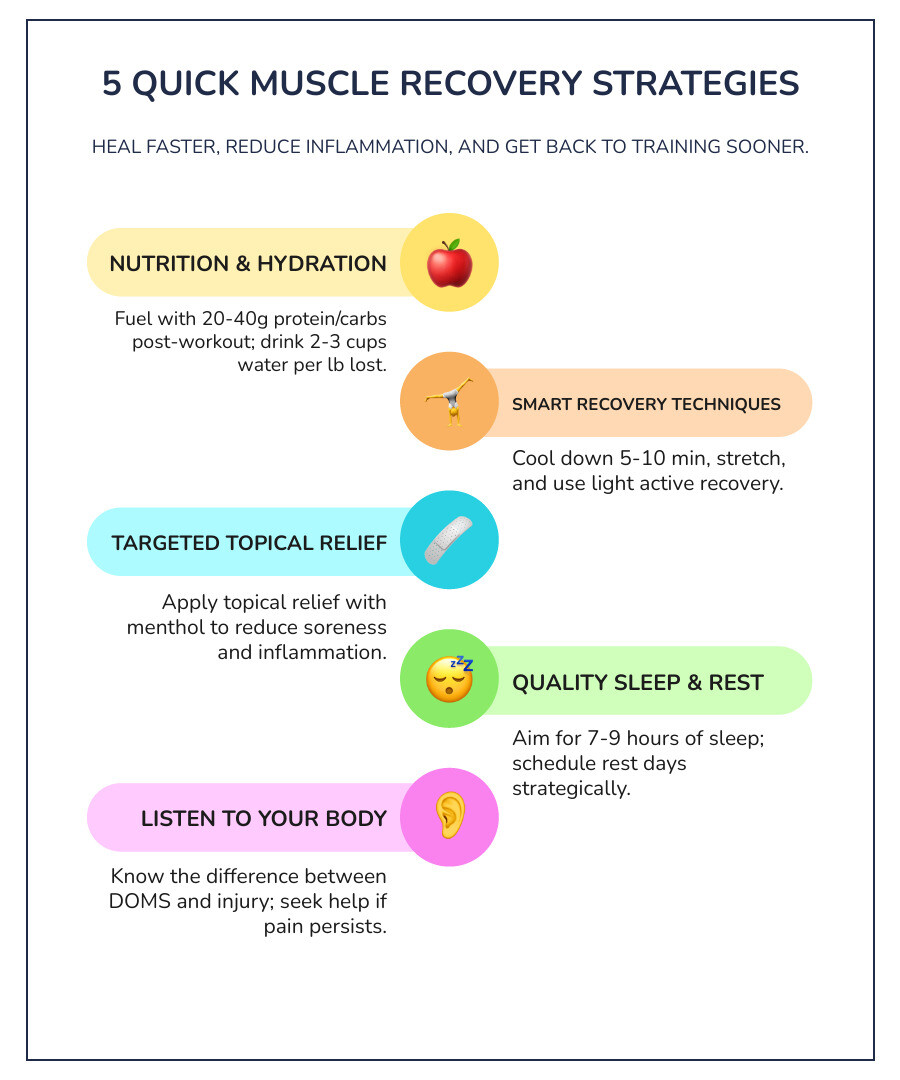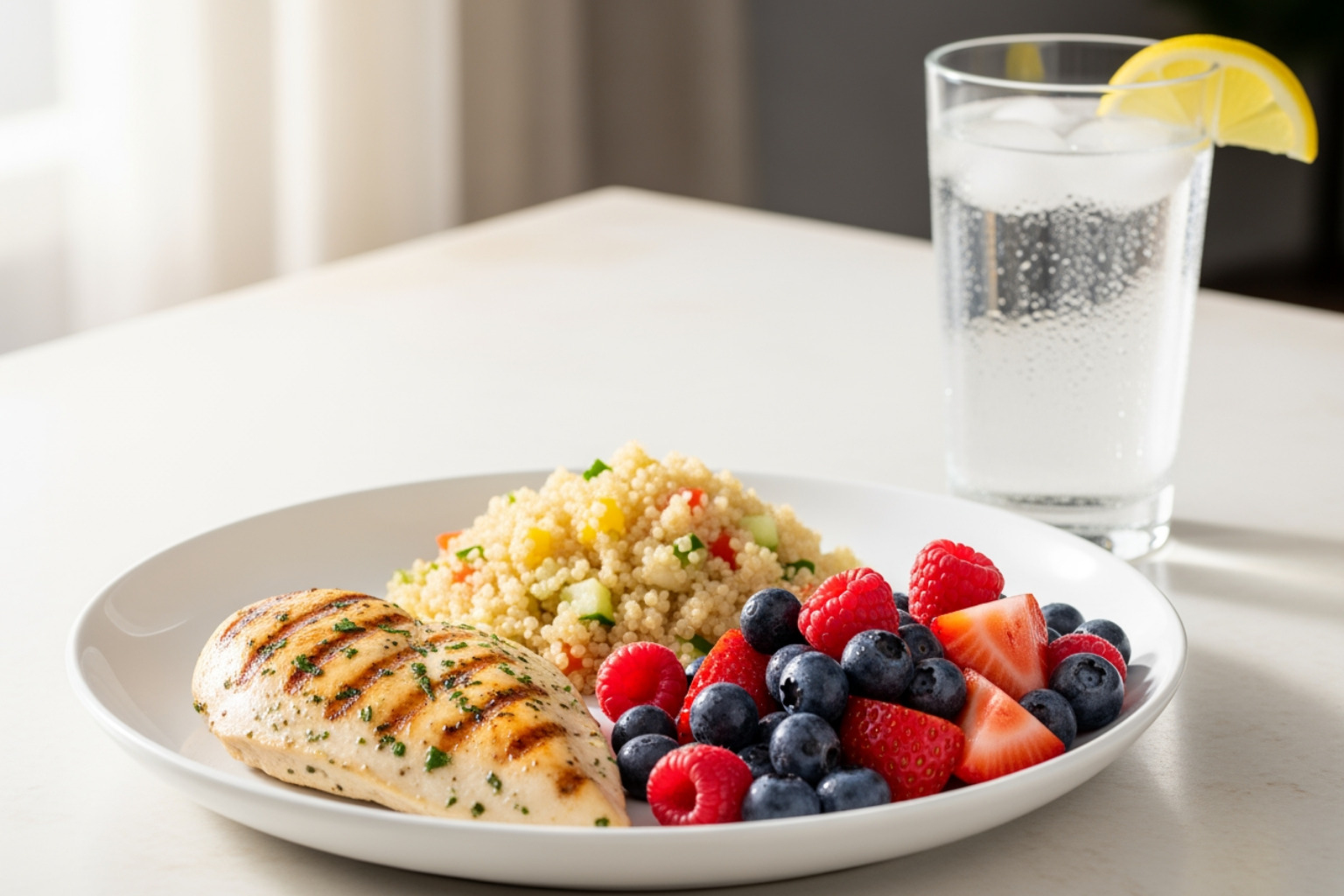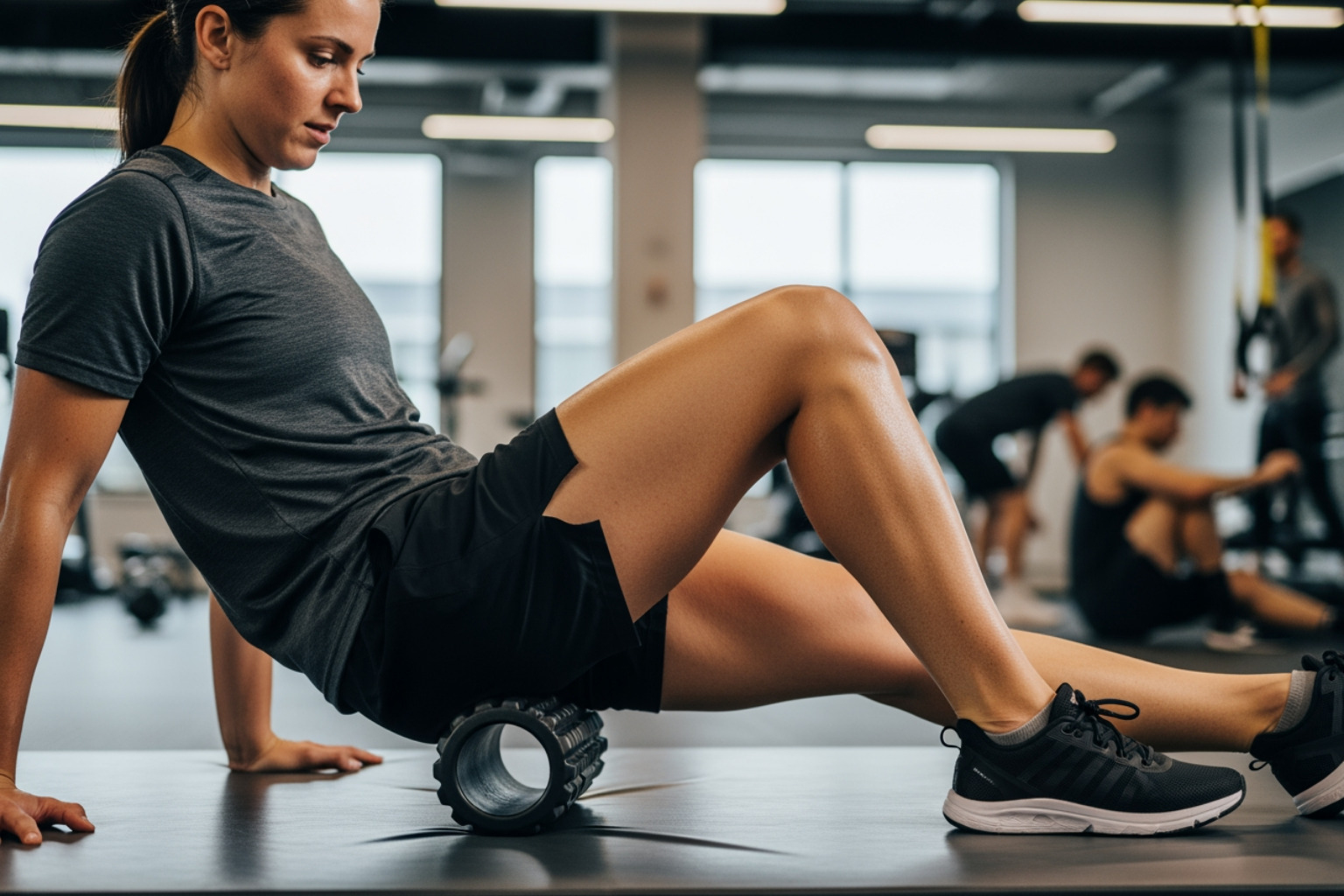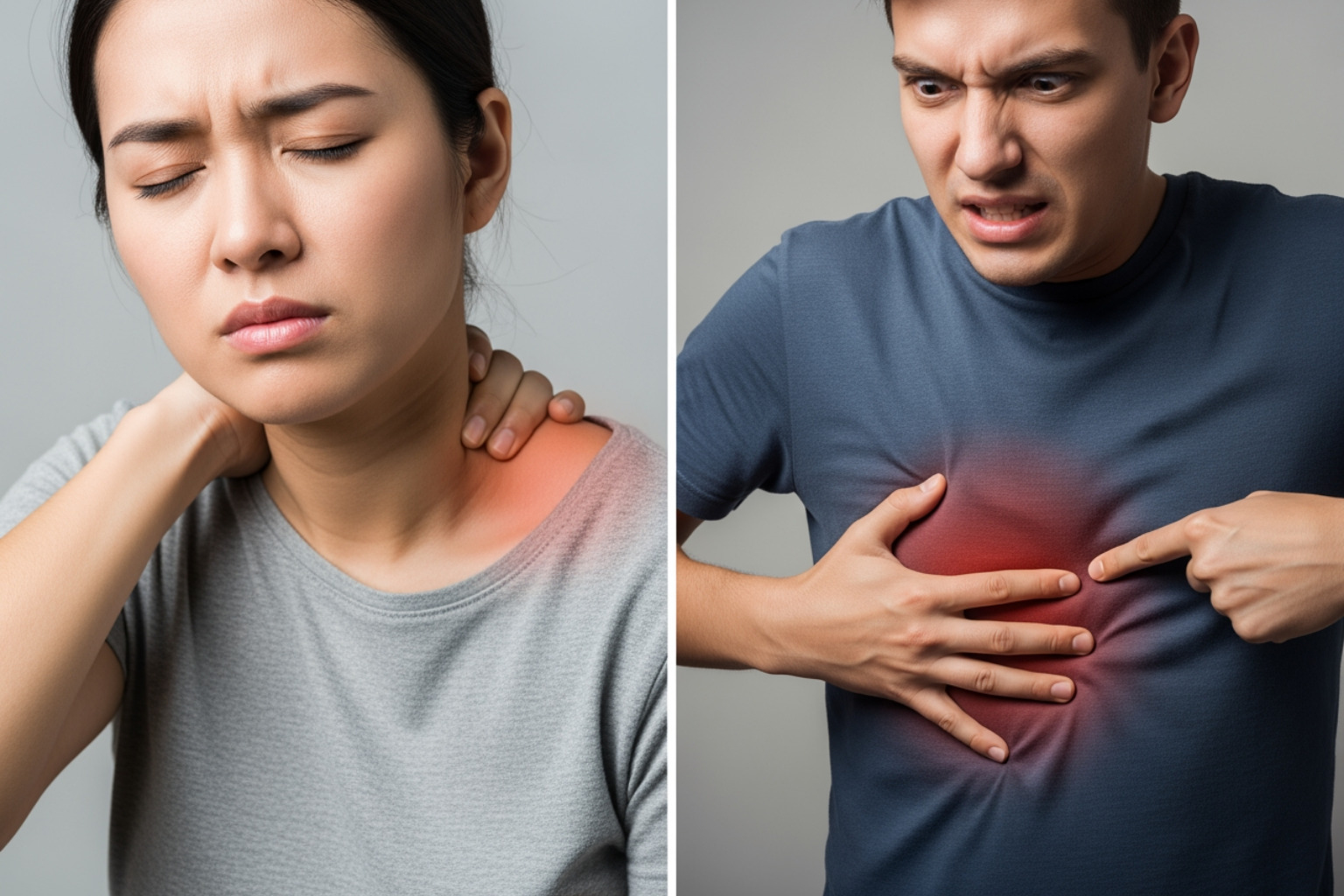Why Quick Muscle Recovery Matters for Your Performance and Long-Term Health
Quick muscle recovery is essential for anyone who trains hard, from athletes chasing performance goals to individuals managing persistent muscle pain. The faster you recover, the sooner you can train again—and the less likely you are to suffer from chronic soreness or injury.
When you exercise, your muscles get microscopic tears. This triggers inflammation and Delayed Onset Muscle Soreness (DOMS)—that familiar ache peaking 24-48 hours post-workout. While this is a normal part of getting stronger, you don't have to suffer through days of pain.
Here are the 5 key changes for quick muscle recovery:
- Master Post-Workout Nutrition and Hydration: Refuel with protein and carbs, and drink plenty of water.
- Implement Smart Recovery Techniques: Use cool-downs, stretching, and active recovery.
- Leverage Targeted Topical Relief: Apply creams with menthol for immediate comfort.
- Prioritize Quality Sleep and Rest: Aim for 7-9 hours of sleep and schedule rest days.
- Listen to Your Body: Know the difference between soreness and injury.
I'm Tony Enrico, and through my work with Neuropasil, I've seen how combining science-backed strategies with targeted topical relief can transform an individual's ability to train consistently and live pain-free. This guide offers five simple, actionable changes to help your muscles heal faster, reduce inflammation, and keep you moving toward your goals.

Important quick muscle recovery terms:
Change 1: Master Your Post-Workout Nutrition and Hydration
Think of your body post-workout as a construction site needing materials and water. That's what quick muscle recovery is—giving your muscles the fuel and hydration they need to repair and rebuild stronger. Without them, soreness lingers and fatigue sets in. Get these fundamentals right, and you'll bounce back faster.

Refuel with Protein and Carbs for Quick Muscle Recovery
Exercise creates micro-tears in muscle fibers, which is how they grow stronger. To heal, they need the right building materials.
Protein provides the amino acids to rebuild damaged muscle fibers. Carbohydrates are just as crucial, as they replenish the muscle's energy stores (glycogen) used during your workout. Combining carbs with protein helps restore glycogen more effectively than carbs alone.
Aim to consume 20-40 grams of protein and some carbs within two hours of your workout. While the "anabolic window" isn't as strict as once thought, timely refueling is beneficial. More importantly, focus on your total daily intake. The International Society of Sports Nutrition recommends 1.4 to 2.0 grams of protein per kilogram of body weight per day for active individuals.
Good post-workout options include Greek yogurt with berries, scrambled eggs with toast, or a protein shake with a banana. For more on supplements, see our guide on recovery nutrition and supplements.
Hydrate to Accelerate Healing
Dehydration is a major enemy of muscle recovery. Since muscles are about 75% water, fluid is vital for transporting nutrients and flushing out metabolic waste. Even slight dehydration can intensify and prolong soreness.
During exercise, the American Council on Exercise (ACE) recommends drinking about 7-10 ounces of water every 10-20 minutes. Afterward, a good rule of thumb is to drink 16-24 ounces (2-3 cups) of water for every pound of body weight lost. For workouts over an hour, a sports drink can help replace lost electrolytes like sodium and potassium, as noted by the Mayo Clinic. For most gym sessions, water is sufficient.
Eat to Fight Inflammation
While some inflammation is a normal part of the repair process, excessive inflammation slows recovery. Certain foods can help manage it:
- Anti-inflammatory Foods: According to Harvard Health, foods like tart cherries, fatty fish (like salmon), leafy greens (spinach, kale), and berries are packed with antioxidants and omega-3s that fight inflammation.
- Foods to Limit: Added sugars, highly processed foods, and fried foods promote inflammation. Alcohol is particularly damaging, as research shows it interferes with the muscle repair process and can hinder muscle growth.
Choosing the right foods is an active strategy for achieving quick muscle recovery.
Change 2: Implement Smart Recovery Techniques Immediately After Exercise
What you do in the first few minutes and hours after exercise can dramatically impact your recovery time. These smart techniques keep blood flowing, prevent stiffness, and are essential for quick muscle recovery.

Don't Skip the Cool-Down and Stretching
Stopping intense exercise abruptly can cause blood to pool in your extremities, making you feel dizzy. A 5-10 minute cool-down of low-intensity cardio, like walking or light cycling, helps gradually bring your heart rate and blood pressure back to normal.
After your heart rate settles, it's time for static stretching. While research is mixed on its effect on soreness, stretching is crucial for maintaining flexibility and range of motion, which helps prevent injuries. Hold each stretch for about 30-60 seconds, focusing on the muscles you just worked. The Mayo Clinic emphasizes that a proper cool-down sets the stage for effective recovery.
Accept Active Recovery and Self-Massage
It may seem counterintuitive, but gentle movement often speeds up recovery more than complete rest. This is called active recovery. Light activities like walking, easy cycling, or swimming increase blood flow to sore muscles, delivering nutrients and flushing out metabolic waste without causing new damage.
Self-massage is another powerful tool. A 2018 meta-analysis in Frontiers in Physiology found that massage was the most effective technique for reducing delayed-onset muscle soreness (DOMS) and fatigue. Using a foam roller or massage ball helps release muscle tightness and boost circulation. Spend 10-15 minutes rolling slowly over major muscle groups, pausing on tender spots for 20-30 seconds, a protocol supported by research in the International Journal of Sports Physical Therapy. For more tips, see our guide on how to reduce muscle soreness.
Change 3: Leverage Targeted Topical Relief for Pain and Inflammation
Even with perfect nutrition and smart techniques, muscle soreness can still happen. Sometimes, you just need relief now. This is where targeted topical solutions become a key part of your toolkit for quick muscle recovery.

Use Neuropasil for Quick Muscle Recovery
Topical pain relievers work by creating sensations that interrupt pain signals traveling to your brain, a mechanism known as counter-irritation. Products like Neuropasil use ingredients like menthol to produce a cooling feeling that your nervous system prioritizes over the dull ache of muscle soreness. Research shows that menthol activates specific sensory receptors in the skin, effectively masking the pain signals from the muscle. The result is immediate, noticeable comfort.
For anyone with an active lifestyle, this targeted relief is a game-changer. Neuropasil was designed with this in mind. Our natural formula combines Aloe, Urea, and Menthol to penetrate the skin and deliver relief right where it's needed. The menthol provides a cooling sensation that masks pain, while aloe and urea nourish the skin and improve absorption.
Applying Neuropasil after a workout helps you move more comfortably, reduces stress, and can even lead to better sleep—all of which contribute to a positive recovery cycle. Learn more about how Neuropasil helps athletes with muscle recovery pain.
Try Simple At-Home Relief Methods
Beyond topical creams, a few simple strategies can improve your comfort. Gentle stretching throughout the day prevents stiffness, while elevating your legs can reduce swelling after a tough workout. And of course, sometimes the best thing you can do is simply rest.
Incorporate Neuropasil into your routine by applying it to sore areas after a shower. Massage it in gently until absorbed. This simple ritual can provide significant comfort and support your body's healing process. For more ideas, check out these tips for muscle pain relief.
Change 4: Prioritize Quality Sleep and Rest
We often focus on workouts and nutrition, but what happens when we're asleep is just as critical. If you want quick muscle recovery, you must treat sleep and rest as essential components of your training.

Understand Why Sleep is the Ultimate Recovery Tool
Your body does its most important repair work while you sleep. During deep sleep, your body releases growth hormone, which drives tissue repair and muscle growth. This is when protein synthesis—the process of building new muscle fibers—is at its peak.
Lack of sleep disrupts this process. It can interfere with hormones that support muscle growth and raise levels of the stress hormone cortisol, which breaks down muscle tissue. Most adults need seven to nine hours of quality sleep per night for proper recovery, a recommendation supported by the CDC, especially when training hard. If you're constantly tired or sore, your body is likely asking for more sleep. Research confirms that sleep deprivation impairs muscle recovery.
Schedule Rest Days Strategically
Rest days are when you actually get stronger. Workouts create the stimulus for growth, but the adaptation happens during recovery. Without adequate rest, you're just breaking down tissue without giving it time to rebuild.
How much rest you need depends on the intensity of your workout. A light session may only require 24 hours of recovery, while a very intense workout might need 48 to 72 hours before that muscle group is ready again. The American College of Sports Medicine (ACSM), for example, recommends at least 48 hours of rest for a muscle group after a vigorous resistance training session.
On rest days, consider active recovery—gentle movement like walking or yoga keeps blood flowing to support healing without adding stress. The biggest mistake is ignoring your body's signals. Persistent soreness and fatigue are signs you need more rest. Pushing through increases your risk of injury. Listen to your body; it's okay to take an extra rest day.
Change 5: Listen to Your Body—Know Soreness from Injury
Is that post-workout ache a good sign or something more serious? Learning to distinguish between normal muscle soreness and an actual injury is a crucial skill for sustainable training and quick muscle recovery.

What is DOMS (and Why Does it Happen)?
If you've ever felt stiff and achy a day or two after a tough workout, you've experienced Delayed Onset Muscle Soreness (DOMS). It typically peaks 24-48 hours after exercise. DOMS is caused by microscopic tears in your muscle fibers, which is a normal and necessary part of getting stronger. Your body's inflammatory response to repair this damage causes the soreness. In short, DOMS is a sign that your muscles are adapting.
How to Tell if It's Soreness or a Serious Injury
Listening to your body is key. Here’s how to tell the difference between normal soreness and a potential injury:
| Feature | Muscle Soreness (DOMS) | Muscle Injury (Strain) |
|---|---|---|
| Feeling | Dull, generalized ache | Sharp, localized pain |
| Onset | 12-48 hours after exercise | Immediately or very soon after |
| Effect of Movement | Improves with gentle movement | Worsens with specific movements |
| Visible Signs | Rarely any swelling or bruising | Often swelling, bruising, or a dent |
A good guideline is the "day three rule": if your pain is getting worse by day three, it's more likely an injury than DOMS. As advised by experts at Harvard Medical School, if pain is severe or doesn't improve after a few days, you should consult a doctor. If you experience a pop, immediate intense pain, significant swelling, or can't move a limb, seek medical attention right away. For more on this, see our guide to muscle strain treatment.
The Long-Term Payoff of Prioritizing Recovery
Consistently prioritizing recovery offers significant long-term benefits that transform your fitness experience:
- Improved Performance: Recovered muscles are stronger and have greater endurance.
- Injury Prevention: Proper recovery reduces the risk of overtraining and strains, keeping you in the game.
- Consistency: Less downtime means you can stick to your training schedule, which is the key to lasting results.
- Improved Muscle Growth: Muscles grow during rest, not during the workout. Optimizing recovery maximizes this process.
- Sustainability: A routine that includes recovery is one you can maintain for life, making fitness an enjoyable, long-term journey.
Frequently Asked Questions about Quick Muscle Recovery
What is the fastest way to get rid of muscle soreness?
There's no single magic bullet, but a combination approach is fastest. For quick muscle recovery, immediately hydrate and refuel with a protein-and-carb snack. Incorporate light active recovery, like walking, to keep blood flowing. Prioritize 7-9 hours of quality sleep for deep tissue repair. For immediate comfort, apply a topical cream like Neuropasil. Its natural formula with Menthol provides soothing relief, making the recovery period more comfortable.
Are supplements necessary for muscle recovery?
A balanced, whole-food diet is your foundation. However, supplements can be a convenient way to support your goals. Protein powders help you meet daily protein targets, and creatine monohydrate is well-researched for improving recovery and performance. Think of them as helpers, not replacements for a good diet. Topical products like Neuropasil offer a different kind of support by providing targeted pain relief right where you need it. For more details, see our guide on recovery nutrition and supplements.
How long should you rest sore muscles?
This depends on workout intensity. A light session might only require 24 hours of rest for a muscle group. A more intense workout could demand 48 to 72 hours for full recovery. The best guide is your body. If you're still significantly sore or your range of motion is limited, take another day. Pushing through severe soreness increases injury risk, and leading fitness organizations like the ACSM recommend at least 48 hours of rest between intense sessions for the same muscle group. It's better to take an extra rest day and come back strong for a productive workout.
Conclusion
We've covered five powerful strategies for quick muscle recovery: mastering nutrition and hydration, using smart cool-down techniques, leveraging targeted topical relief, prioritizing sleep, and listening to your body.
Recovery isn't a one-time fix; it's a system of small, consistent habits. That post-workout snack, extra hour of sleep, or gentle stretching session adds up. Over time, you'll train harder, recover faster, and stay injury-free. Prioritizing recovery transforms fitness from a battle against soreness into an energizing and sustainable practice.
When post-workout soreness inevitably strikes, athletes and active people in New York City and beyond turn to Neuropasil for fast, effective relief. Our natural formula, powered by Aloe, Urea, and Menthol, delivers targeted comfort to soothe tired muscles and help you manage discomfort.
Recovery isn't about avoiding hard work—it's about working smarter. By implementing these five changes, you're setting yourself up for a lifetime of strength, resilience, and pain-free movement.
Ready to take control of your recovery? Find the best products for your muscle pain and find how Neuropasil can support your journey.
References
Throughout this guide on quick muscle recovery, we've referenced scientific research and trusted medical sources to ensure our recommendations are evidence-based. Here are the key resources that informed our approach:
American College of Sports Medicine. (2021). Progression Models in Resistance Training for Healthy Adults. This position stand provides evidence-based recommendations for resistance training, including rest periods. https://www.acsm.org/docs/default-source/files-for-resource-library/progression-models-in-resistance-training-for-healthy-adults.pdf
American Council on Exercise (ACE). Healthy Hydration. This resource provides guidelines for fluid intake before, during, and after exercise. https://www.acefitness.org/resources/everyone/blog/6675/healthy-hydration/
Centers for Disease Control and Prevention (CDC). (2022). How Much Sleep Do I Need? This page outlines sleep recommendations for different age groups. https://www.cdc.gov/sleep/aboutsleep/howmuch_sleep.html
Cheatham, S. W., et al. (2015). The effects of self‐myofascial release using a foam roll or roller massager on joint range of motion, muscle recovery, and performance: a systematic review. International Journal of Sports Physical Therapy, 10(6), 827–838. https://www.ncbi.nlm.nih.gov/pmc/articles/PMC4637917/
Dáttilo, M., et al. (2020). Effects of sleep deprivation on acute skeletal muscle recovery after exercise. Medicine and Science in Sports and Exercise, 52(2), 481-490. This study highlights the crucial link between quality sleep and muscle repair. https://journals.lww.com/acsm-msse/Abstract/2020/02000/EffectsofSleepDeprivationonAcuteSkeletal.28.aspx
Dupuy, O., et al. (2018). An Evidence-Based Approach for Choosing Post-exercise Recovery Techniques to Reduce Markers of Muscle Damage, Soreness, and Inflammation: A Systematic Review With Meta-Analysis. Frontiers in Physiology, 9, 446. https://www.ncbi.nlm.nih.gov/pmc/articles/PMC5932411/
Harvard Health Publishing. (2022). Foods that fight inflammation. Harvard Medical School provides a list of anti-inflammatory foods. https://www.health.harvard.edu/staying-healthy/foods-that-fight-inflammation
Harvard Health Publishing. (2022). Best ways to recover from a muscle strain. Harvard Medical School offers practical guidance on distinguishing between normal soreness and injury. https://www.health.harvard.edu/staying-healthy/best-ways-to-recover-from-a-muscle-strain
Jäger, R., et al. (2017). International Society of Sports Nutrition Position Stand: protein and exercise. Journal of the International Society of Sports Nutrition, 14, 20. https://jissn.biomedcentral.com/articles/10.1186/s12970-017-0177-8
Jéquier, E., & Constant, F. (2010). Water as an essential nutrient: the physiological basis of hydration. European Journal of Clinical Nutrition, 64(2), 115-123. This paper discusses the water content of the human body. https://www.nature.com/articles/ejcn2009111
Lakićević, N., et al. (2019). The effects of alcohol consumption on recovery following resistance exercise: A systematic review. Nutrients, 11(12), 2977. This review examines how alcohol can significantly slow down muscle recovery. https://www.ncbi.nlm.nih.gov/pmc/articles/PMC7739274/
Mayo Clinic. (2022). Cool down after exercise. This resource provides clear guidance on the importance of proper cool-down techniques. https://www.mayoclinic.org/healthy-lifestyle/fitness/in-depth/exercise/art-20045517
Mayo Clinic. (2023). Sports drinks: Do you need them? This resource clarifies when sports drinks are beneficial for hydration and recovery. https://www.mayoclinic.org/healthy-lifestyle/fitness/in-depth/exercise/art-20045506
Pergolizzi, J. V., et al. (2018). The role of topical analgesics in the management of acute and chronic pain: a narrative review. Pain and Therapy, 7(2), 1-16. This review discusses the mechanism of action for topical ingredients like menthol. https://www.ncbi.nlm.nih.gov/pmc/articles/PMC6277320/
Rodrigues, F., et al. (2023). The association between training frequency, symptoms of overtraining and injuries in young men soccer players. Biology of Sport, 40(2), 527-537. This study highlights the risks associated with insufficient rest between training sessions. https://www.ncbi.nlm.nih.gov/pmc/articles/PMC10138529/
Wax, B., et al. (2021). Creatine for Exercise and Sports Performance, with Recovery Considerations for Healthy Populations. Nutrients, 13(6), 1915. This review covers the benefits of creatine for performance and recovery. https://www.ncbi.nlm.nih.gov/pmc/articles/PMC8228369/













